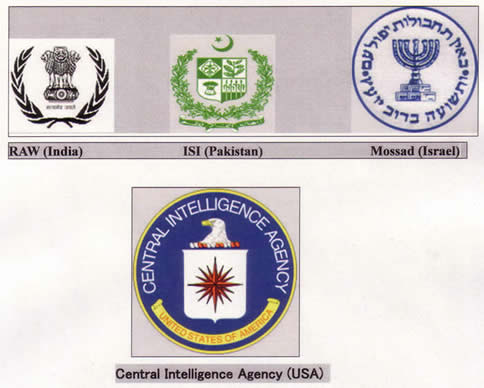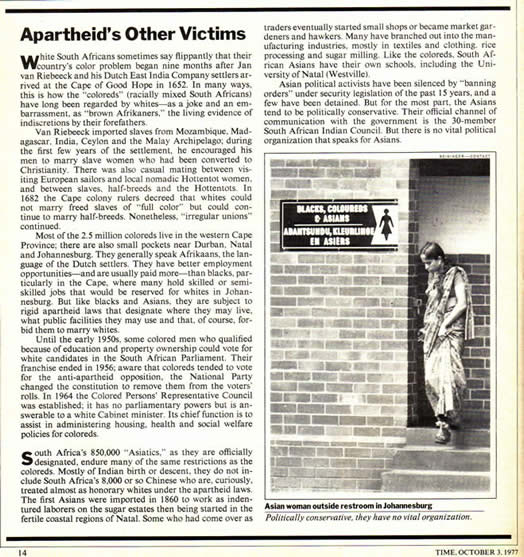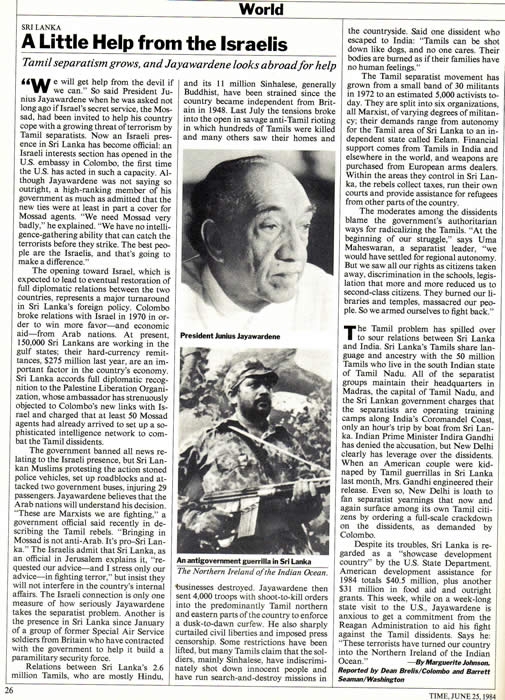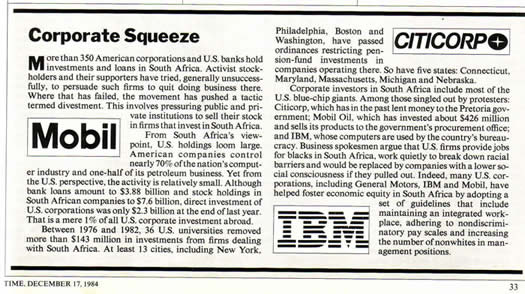Ilankai Tamil Sangam30th Year on the Web Association of Tamils of Sri Lanka in the USA |
|||
 Home Home Archives Archives |
Prabhakaran’s Tigers and Mandela’s SpearsPart 5by Sachi Sri Kantha, March 11, 2012
Comparing the ‘Irritant Load’ between LTTE and MK The study by Rene Bakker, Jorg Raab and Brinton Milward on the dark networks which included LTTE and Umkhonto we Sizwe (MK), the armed wing of the African National Congress (ANC) had eventually received pagination this year [Journal of Policy Analysis and Management, 2012; 31(1): 33-62]. Last year, it first appeared in the electronic version. As such, I provide the new citation numbers. In this part, I offer some relevant details that were missing in this publication. One important component is what I term as ‘irritant load’. The New Oxford American Dictionary (2001) defines an irritant as, “a substance that causes slight inflammation or other discomfort to the body”. The word ‘body’ could refer to an individual (animal or human), plant, institution or an organization. It is common sense that for the health and vibrancy of an institution or an individual, irritants had to be checked and controlled. In my opinion, one of the reasons why LTTE became non-resilient in 2009, while MK became robust was the irritant load quotient of LTTE was higher than that of MK. I list some commonalities from this angle shared by LTTE and MK.
In political and social arena, there have been many parallels between the recent-Indian origin populations in South Africa and Sri Lanka (then Ceylon), when the 1948 general elections held in both countries. While, Daniel Malan’s party in South Africa instituted its policy of grand apartheid, Don Stephen Senanayake-led UNP in Ceylon enacted the 1948 Ceylon Citizenship Act No.18, to deprive citizenship to the plantation workers of recent-Indian origin. However, thirty years later by 1978, the political leadership of the dominant Ceylon Workers Congress of the Indian population in Sri Lanka was ‘bought over’ for a single Cabinet level position by the same UNP party. But this could not happen in South Africa, as the Indians there were politically powerless, and numerically (around 850,000 in a population of over 30 million in 1970s) a miniscule minority. I provide one paragraph from Nelson Mandela’s autobiography: “Both the [South African] government and the ANC were working on two tracks: military and political. On the political front, the government was pursuing its standard divide-and-rule strategy in attempting to separate Africans from Coloureds and Indians. In a referendum of November 1983, the white electorate endorsed P.W.Botha’s plan to create a so-called tri-cameral Parliament, with Indian and Coloured chambers in addition to the white Parliament. This was an effort to lure Indians and Coloureds into the system, and divide them from Africans. But the offer was merely a ‘toy telephone’, as all parliamentary action by Indians and Coloureds was subject to a white veto. It was also a way of fooling the outside world into thinking that the government was reforming apartheid. Botha’s ruse did not fool the people, as more than 80 percent of eligible Indian and Coloured voters boycotted the election to the new houses of Parliament in 1984.” [Long Walk to Freedom, 1994, pp. 518-519].
Here are the statistics of the Muslim population in South Africa and Sri Lanka. In South Africa, among a population of 49,109,107 (mid-2010 estimate), Muslims constitute only 737,000 (1.5% of the total population). In Sri Lanka, among a population of 20,653,000 (mid-2010 estimate), Muslims form a sizeable 1,725,000 (~8.5% of the total population). In South Africa, in proportion to the total population, the Muslims as a political cohort per se are unviable and the political parties based on their religion have not had any success in general elections. Though majority of the Sri Lankan Muslims were Tamil-speaking, for political and business reasons, they sided with LTTE’s native adversaries. It is a sad fact to note that in the independent Sri Lanka, Muslim politicians have functioned as serial two timers! (see, the next item below on the activity of external gumshoes, for evidence). It should not be forgotten that Muslims were also recruited by SL army for intelligence-gathering operations in two of the Tamil dominant districts. In this aspect too, Mandela was blessed, but Prabhakaran was unlucky! The duplicity of Sri Lanka’s Muslim politicos in supporting Pakistan’s split from India (on religious rationale), while opposing Eelam’s split from Sri Lanka (on linguistic and religious rationale) deserve mention as well.
Being a dark network, the activities of both LTTE and MK were monitored by their native adversaries within Sri Lanka and South Africa respectively. Sri Lanka established the State Intelligence Service (SIS) in 1984. The National Intelligence Service (NIS) was formed in South Africa in 1980. Apart from tackling the ‘national’ gumshoes, it can be assumed that both LTTE and MK also attracted the attention of Uncle Sam’s CIA. Mandela makes a passing mention to this in his autobiography. There is indirect evidence that CIA also did not leave LTTE alone, as I have pointed out in my previous commentaries and essays in this website. In addition to CIA’s activities, LTTE also had to carry the burden of tackling India’s RAW, Pakistan’s ISI, Israel’s Mossad, as India, Pakistan and Israel delivered mercenaries, weapons and military advice to SL army. In this aspect too, Mandela was blessed but Prabhakaran was unlucky.
I provide a scan of a Marguerite Johnson report that appeared in the Time magazine of June 25, 1984. It was titled, ‘A Little Help from the Israelis: Tamil separatism grows, and Jayawardene looks abroad for help’. To the best of my research knowledge, this item was the first one in which LTTE’s leader Prabhakaran made an uncredited appearance [‘an antigovernment guerrilla in Sri Lanka’] in Time. I list the six essential points which I noted: (a) As it provides minimal facts about Mossad involvement, and also the involvement of RAW [not openly stated, but could be inferred!], it deserves preservation. (b) It could be implied that without CIA’s consultation and blessing, Mossad wouldn’t have landed a contract from J.R. Jayewardene, as the Israeli interests section was opened in the US embassy in Colombo in 1984. It could be guessed that the ‘high-ranking Cabinet member cited in the report was none other than Lalith Athulathmudali, who was later openly identified by R. Premadasa, his Cabinet colleague and successor to President Jayewardene. (c) Though Prabhakaran’s photo was featured, the text makes a passing reference to the PLOTE leader Uma Maheswaran (who was for a while the head of LTTE, before his expulsion. (d) The text does not identify LTTE by name. At that time, all the Tamil fighters were called by the generic term ‘Tamil Tigers’. (e) Though the text states that the Tamil separatist movement was “split into six organizations, all Marxist, of varying degrees of militancy”, that allusion to Marxism was merely an embellishment to balance J.R. Jayewardene’s pro-West policies. LTTE was not Marxist! (f) The text also provides some evidence for the serial two-timer role played by Muslim politicians. Initially on religious grounds and in sympathy to Palestine folks, they opposed Mossad’s involvement in Sri Lanka. Later, they switched to the side of Sinhalese government. For the record, I reproduce the complete text of this report, is as follows: “ ‘We will get help from the devil if we can.’ So said President Junius Jayawardene when he was asked not long ago if Israel’s secret service, the Mossad, had been invited to help his country cope with the growing threat of terrorism by Tamil separatists. Now an Israeli presence in Sri Lanka has become official: an Israeli interests section has opened in the US embassy in Colombo, the first time the US has acted in such a capacity. Although Jayawardene was not saying so outright, a high-ranking member of his government as much as admitted that the new ties were at least in part a cover for Mossad agents. ‘We need Mossad very badly’, he explained. ‘We have no intelligence-gathering ability that can catch the terrorists before they strike. The best people are the Israelis, and that’s going to make a difference.’ The opening toward Israel, which is expected to lead to eventual restoration of full diplomatic relations between the two countries, represents a major turnaround in Sri Lanka’s foreign policy. Colombo broke relations with Israel in 1970 in order to win more favor – and economic aid – from Arab nations. At present, 150,000 Sri Lankans are working in the Gulf states; their hard-currency remittances, $275 million last year, are an important factor in the country’s economy. Sri Lanka accords full diplomatic recognition to the Palestine Liberation Organization, whose ambassador has strenuously objected to Colombo’s new links with Israel and charged that at least 50 Mossad agents had already arrived to set up a sophisticated intelligence network to combat the Tamil dissidents. The government banned all news relating to the Israeli presence, but Sri Lankan Muslims protesting the action stoned police vehicles, set up roadblocks and attacked two government buses, injuring 29 passengers. Jayawardene believes that the Arab nations will understand his decision. ‘These are Marxists we are fighting’, a government official said recently in describing the Tamil rebels. ‘Bringing in Mossad is not anti-Arab. It’s pro-Sri Lanka.’ The Israelis admit that Sri Lanka as an official in Jerusalem explains it, ‘requested our advice – and I stress only our advice – in fighting terror’, but insist they will not interfere in the country’s internal affairs. The Israeli connection is only one measure of how seriously Jayawardene takes the separatist problem. Another is the presence in Sri Lanka since January of a group of former Special Air Service soldiers from Britain who have contracted with the government to help it build a paramilitary security service. Relations between Sri Lanka’s 2.6 million Tamils, who are mostly Hindu, and its 11 million Sinhalese, generally Buddhist, have been strained since the country became independent from Britain in 1948. Last July the tensions broke into the open in savage anti-Tamil rioting in which hundreds of Tamils were killed and many others saw their homes and businesses destroyed. Jayawardene then sent 4,000 troops with shoot-to-kill orders into the predominantly Tamil northern and eastern parts of the country to enforce a dusk-to-dawn curfew. He also sharply curtailed civil liberties and imposed press censorship. Some restrictions have been lifted, but many Tamils claim that the soldiers, mainly Sinhalese, have indiscriminately shot down innocent people and have run search-and-destroy missions in the countryside. Said one dissident who escaped to India: ‘Tamils can be shot down like dogs, and no one cares. Their bodies are burned as if their families have no human feelings.’ The Tamil separatist movement has grown from a small band of 30 militants in 1972 to an estimated 5,000 activists today. They are split into six organizations, all Marxist, of varying degrees of militancy; their demands range from autonomy for the Tamil area of Sri Lanka to an independent state called Eelam. Financial support comes from Tamils in India and elsewhere in the world, and weapons are purchased from European arms dealers. Within the areas they control in Sri Lanka, the rebels collect taxes, run their own courts and provide assistance for refugees from other parts of the country. The moderates among the dissidents blame the government’s authoritarian ways for radicalizing the Tamils. ‘At the beginning of our struggle,’ says Uma Maheswaran, a separatist leader, ‘we would have settled for regional autonomy. But we saw all our rights as citizens taken away, discrimination in the schools, legislation that more and more reduced us to second-class citizens. They burned our libraries and temples, massacred our people. So we armed ourselves to fight back.’ The Tamil problem has spilled over to sour relations between Sri Lanka and India. Sri Lanka’s Tamils share language and ancestry with the 50 million Tamils who live in the south Indian state of Tamil Nadu. All the separatist groups maintain their headquarters in Madras, the capital of Tamil Nadu, and the Sri Lankan government charges that the separatists are operating training camps along India’s Coromandel Coast, only an hour’s trip by boat from Sri Lanka. Indian prime minister Indira Gandhi has denied the accusation, but New Delhi clearly has leverage over the dissidents. When an American couple were kidnaped by Tamil guerrillas in Sri Lanka last month, Mrs. Gandhi engineered their release. Even so, New Delhi is loath to fan separatist yearnings that now and again surface among its own Tamil citizens by ordering a full-scale crackdown on the dissidents, as demanded by Colombo. Despite its troubles, Sri Lanka is regarded as a ‘showcase development country’ by the US State Department. American development assistance for 1984 totals $40.5 million, plus another $31 million in food aid and outright grants. This week, while on a week-long state visit to the US, Jayawardene is anxious to get a commitment from the Reagan administration to aid his fight against the Tamil dissidents. Says he: ‘These terrorists have turned out country into the Northern Ireland of the Indian Ocean.’
That J.R. Jayewardene was a shrewd fox is evident, when he incorporated the then President Ronald Reagan’s ancestral land Ireland into his cynical attack on Tamil dissidents. However, this ploy failed to work to his advantage during Reagan’s presidency. The guy [Douglas Devananda] who was involved in the 1984 kidnapping of American couple in Jaffna belonged to the Marxist-EPRLF militant group, did receive ‘some’ training from Palestinian groups in early 1980s, and is currently a Cabinet minister in President Mahinda Rajapaksa government.
In my view, international human rights propagandists [the likes of NGO nitpickers Amnesty International (UK) and Human Rights Watch (USA)] were the 20th century incarnation of R.L.Stevenson’s 1886 creation Dr. Jekyll and Mr. Hyde. While soft pedaling the misdeeds of the secretive networks and military institutions of their mother countries (Britain and USA), they revel in producing voluminous nitpicking reports to harass liberation movements like MK and LTTE. Mandela’s prick on the Amnesty International’s activity is worth repeating here: “Even during the bleakest years on Robben Island, Amnesty International would not campaign for us on the grounds that we had pursued an armed struggle, and their organization would not represent anyone who had embraced violence.” [Long Walk to Freedom, 1994, p. 612]. That these nitpickers wittingly permitted themselves to be infiltrated with gumshoe operatives was a black eye to their moral vacuum and reputation. This allegation was made by none other than Peter Benenson (1921-2005), the founder of Amnesty International in 1961. Not only advocacy groups like Amnesty International, but also WASP-dominated mainstream media did remain as an irritant for both MK and LTTE.
A listing of ‘limitations’ by Bakker and colleagues Rene Bakker et al., at the end of their analysis, had offered six limitations for their data and analysis. These are as follows:
First, let me comment on the sixth limitation mentioned. The so-called ‘limited access to direct, firsthand data” is not a serious issue. Rather than depending on dubious sources like a self-proclaimed LTTE expert (Rohan Gunaratna), if only these researchers are willing to invest time, energy and enthusiasm in learning the Tamil language and traveling to North-East regions of Sri Lanka, they will be better served in finding firsthand information on LTTE. Secondly, the first limitation mentioned (‘lacking a broader empirical base’) is valid. As I had previously commented in this series, if Bakker and colleagues had included an institutionalized control dark network (the activities of CIA and KGB and its successor have been well recorded for contemporary times) for proper perspectives, this limitation could have been solved. Other four limitations can also be overcome by the inclusion of control institutionalized dark networks in their analysis. As a prospective institutionalized control dark network, activities of CIA and the leadership of CIA directors that spanned the active phases of MK (1961 to 1990) and LTTE (1972 to 2009) deserve a comparative study. The names of those nifty directors with tenures exceeding more than a year, until May 2009 are listed below. Allen W. Dulles (from 1953 Feb.26 to 1961 Nov. 29) John McCone (from 1961 Nov.29 to 1965 Apr. 28) William F. Raborn (from 1965 Apr.28 to 1966 Jun. 30) Richard Helms (from 1966 Jun 30 to 1973 Feb.2) William Colby (from 1973 Sept 4 to 1976 Jan.30) Stansfield Turner (from 1977 Mar 9 to 1981 Jan. 20) William Casey (from 1981 Jan. 28 to 1987 Jan. 29) William Webster (from 1987 May 26 to 1991 Aug. 31) Robert M. Gates (from 1991 Nov.6 to 1993 Jan. 20) James Woolsey (from 1993 Feb. 5 to 1995 Jan. 10) John Deutsch (from 1995 May 10 to 1996 Dec.15) George Tenet (from 1997 Jul.11 to 2004 Jul.11) Porter Goss (from 2004 Sep.22 to 2006 May 5) Michael V. Hayden (from 2006 May 30 to 2009 Feb.12) Omitted from this list were the names of James R. Schlesinger and George H.W.Bush, whose tenures as the director of CIA were less than a year. Other Omissions by Bakker and colleagues Previously, I have mentioned about the WASP-dominated advocacy groups. To this group should also be added, the language-challenged and culture-challenged academics and analysts, who pursue their ‘research interest’ for soliciting research grants, travel funds from federal agencies. As such, they need to advocate the weather-vane type political interests and fads of the day (communism, terrorism, environmentalism). I quote another paragraph from Mandela’s autobiography which dealt with these types. “I had one not-so-pleasant visit from two Americans, editors of the conservative newspaper the Washington Times. They seemed less intent on finding out my views than on proving that I was a Communist and a terrorist. All of their questions were slanted in that direction, and when I reiterated that I was neither a Communist nor a terrorist, they attempted to show that I was not a Christian either by asserting that the Reverend Martin Luther King never resorted to violence. I told them that the conditions in which Martin Luther King struggled were totally different from my own: the United States was a democracy with constitutional guarantees of equal rights that protected nonviolent protest (though there was still prejudice against Blacks); South Africa was a police state with a constitution that enshrined inequality and an army that responded to nonviolence with force. I told them that I was a Christian and had always been a Christian. Even Christ, I said, when he was left with no alternative, used force to expel the moneylenders from the temple. He was not a man of violence, but had no choice but to use force against evil. I do not think I persuaded them.” [Long Walk to Freedom, 1994, pp. 520-521].
What Mandela mentioned about apartheid South Africa, is equally true to the regime of Sinhalese-dominated Sri Lanka as well. Just switch the country name South Africa to Sri Lanka and read his lines again: “Sri Lanka was a police state with a constitution that enshrined inequality and an army that responded to nonviolence with force.” Even LTTE has also been unreasonably criticized by the language-challenged and culture-challenged scribes of the Washington Times, founded in 1982 by money and influence-peddling Unification Church founder Sun Myung Moon. One important reason which had been omitted by Rene Bakker and colleagues in their analysis about why Mandela’s MK struggle in South Africa succeeded, while Prabhakaran’s LTTE struggle failed in Sri Lanka, was the American business investment. I provide a scan from a short box-item in Time magazine of December 17, 1984. It offered the following facts: (1) More than 350 American corporations and US banks hold investments and loans in South Africa. (2) Direct investment of US corporations in South Africa was $2.3 billion at the end of 1983. (3) Corporate investors in South Africa included most of US blue-chip giants; Citicorp, Mobil Oil, IBM, General Motors etc. Neither Prabhakaran’s Eelam nor Sri Lanka had any such large scale American corporate investment, and the land itself was devoid of gold, minerals and other wealth. With turn of tide towards the Black rule in South Africa in early 1990s, it was common sense that America’s decision makers (politicians, business class and clergy) felt that their investments had to be protected at any cost. As such, Mandela was blessed, but Prabhakaran was unlucky. |
||
|
|||

 A box-item on South Africa’s Indians which appeared in the Time magazine (Oct.3, 1977) provides the following detail: “Asian political activists have been silenced by ‘banning orders’ under security legislation of the past 15 years, and a few have been detained. But for the most part, the Asians tend to be politically conservative. Their official channel of communication with the government is the 30-member South African Indian Council. But there is no vital political organization that speaks for Asians.” In this sense, Mandela was blessed, but Prabhakaran was unlucky, because the Indian- origin ethnics in South Africa were forced to side with Mandela, compared to the personality-oriented politics practiced by S. Thondaman Sr., the leader of the Indian plantation workers in Sri Lanka, in plodding his own trail of eventual assimilation of his Tamil tribe into Sinhalese.
A box-item on South Africa’s Indians which appeared in the Time magazine (Oct.3, 1977) provides the following detail: “Asian political activists have been silenced by ‘banning orders’ under security legislation of the past 15 years, and a few have been detained. But for the most part, the Asians tend to be politically conservative. Their official channel of communication with the government is the 30-member South African Indian Council. But there is no vital political organization that speaks for Asians.” In this sense, Mandela was blessed, but Prabhakaran was unlucky, because the Indian- origin ethnics in South Africa were forced to side with Mandela, compared to the personality-oriented politics practiced by S. Thondaman Sr., the leader of the Indian plantation workers in Sri Lanka, in plodding his own trail of eventual assimilation of his Tamil tribe into Sinhalese.

